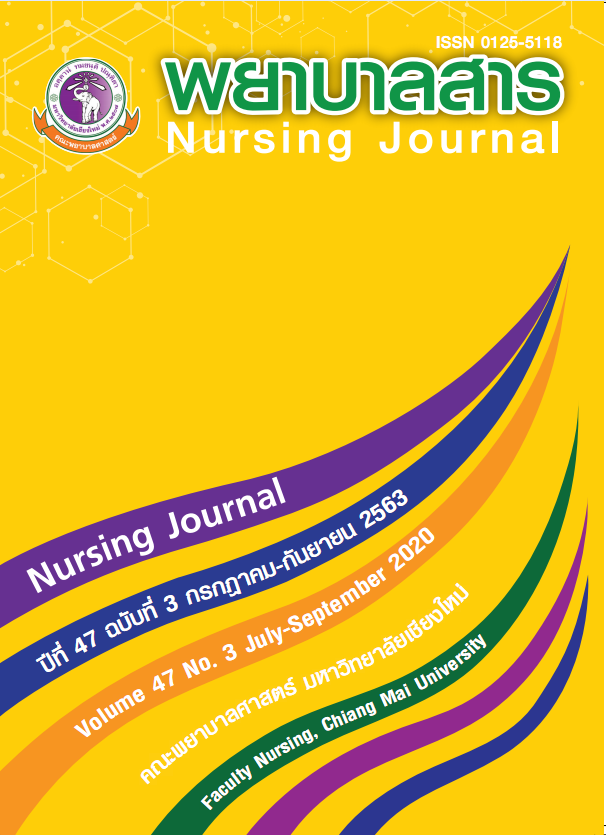Effect of Social Support on Fear of Childbirth Among Primiparous Parturients
Keywords:
social support, fear of childbirth, primiparous parturients, midwiferyAbstract
Fear of childbirth impacts the physiological and psychological health of parturients including their fetus. Therefore, care that lessens fear of childbirth is an important role of nurse-midwives. This quasi-experimental research study aimed to examine the effect of social support on fear of childbirth among primiparous parturients. The subjects were 30 primiparous parturients admitted at the labor unit in the Health Promotion Hospital, Health Promotion Center Region 1, Chiang Mai between June and July 2016. The subjects were selected and assigned in equal numbers into experimental and control groups and matched for age of parturients, medical induction, history of abortion and husband attendance. Subjects in the experimental group received social support from the nurse-midwife, while subjects in the control group received routine care. The research instruments were the social support plan developed by the researcher based on the social support model of Bogossian (2007) and the Fear of Birth Scale by Haines and others (2011). Data were analyzed using descriptive statistics, one-way repeated measures ANOVA and an independent t-test.
The result of the study revealed that the experimental group had significantly lower fear of childbirth than the control group (p < .01)
References
Adams, E. D., & Bianchi, A. L. (2008). A practical approach to labor support. Journal of Obstetric Gynecologic and Neonatal Nursing, 37 (1), 106-115.
Adams, S. S., Eberhard-Gran, M., & Eskild, A. (2012). Fear of childbirth and duration of labour: A study of 2206 women with intended vaginal delivery. British Journal of Obstetrics and Gynaecology, 119, 1238–1246.
Anusornteerakul, S., & Kittiprisada, P. (2013). The effects of health education program and relative assistant on pain, fear, anxiety in primiparous during the first stage of labor. Journal of Nursing Science and Health, 36(1), 23-31. (In Thai)
Bewley, S. & Cockburn, J. (2002). Responding to fear of childbirth. The Lancet, 359, 2128–2129.
Bogossian, F. E. (2007). Social support: Proposing a conceptual model for application to midwifery practice. Women and Birth. 20, 169-173. doi:10.1016/j.wombi.2007.08.003
Bonaro, D., & Kroeger, M. (2004). Continuous female companionsh ip during childbirth: A crucial resource in times of stress or calm. Journal of Midwifery Women’s Health, 49 (1), 19-27.
Chang, M., Wang, S., & Chen, C. (2002). Effects of massage on p ain and anxiety during labour: A randomized controlled trial in Taiwan. Journal of Advanced Nursing, 38 (1), 68–73.
Chuahorm, U., Sripichyakarn, K., Tungpunkom, P., Klunklin, A., & Kennedy, H. P. (2007). Fear and suffering during childbirth among Thai women. Thai Journal Nursing Research, 11 (1), 49-61. (In Thai)
Fenwick, J., Gamble, J., Creedy, D. K., Buist, A., Turkstra, E., & Sneddon, A. (2013). Study protocol for reducing childbirth fear: A midwife-led psycho-education intervention.Biomedical pregnancy and childbirth, 13, 1-9. (In Thai)
Guszkowska, M. (2014). The effect of exercise and childbirth cl asses on fear of childbirth andlocus of labor pain control. Anxiety, Stress, & Coping, 27 (2), 176-189.
Haines, H., Pallant, J. F., Karlstrom, A., & Hildingsson, I. (2011). Cross-cultural comparison of levelsof childbirth-related fear in an Australian and Swedish sample. Midwifery, 27, 560-567.
Hall, W. A., Hauck, Y. L., Carty, E, M., Hutton, E. K., Fenwick, J., & Stoll, K. (2009). Childbirth fear,anxiety, fatigue, and sleep deprivation in pregnant women. Journal of Obstetric Gynecologic& Neonatal Nursing, 38, 567-576. doi:10.1111/j.1552-6909.2009.01054.x
Hildingsson, I., Nilsson, C., Karlstrom, A., & Lundgren, I. (2011). A Longitudinal survey of childbirthrelated fear and associated factors. Journal of Obstetric Gynecologic & Neonatal Nursing, 40(5), 532-543. doi:10.1111/j.1552-6909.2011.01274.x
Khamboon, T. (2008). Touch power: healing power from body through mind. Nursing journal,35 (4), 77-85. (In Thai)
Laursen, M., Hedegaard, M., & Johansen, C. (2008). Fear of childbirth: Predictors and temporal changes among nulliparous women in the Danish national birth cohort. British Journal of Obstetrics and Gynaecology, 15 (3), 354-360
Leap, N., Sandall, J., Buckland, S., & Huber, U. (2010). Journe y to confidence: Women’s experiences of pain in labour and relational continuity of care. Journal of Midwifery and Women’s Health, 55(3), 234–242.
Melender, H. L., & Lauri, S. (1999). Fears associated with pregnancy and childbirth-experiences of women who have recently given birth. Midwifery, 15, 177-182.
Melender, H. L. (2002a). Fears and coping strategies associated with pregnancy and childbirth in Finland. Journal of Midwifery & Women’s Health, 47, 256–263.
Melender, H. L. (2002b). Experiences of fears associated with pregnancy and childbirth: A study of 329 pregnant women. Birth, 29, 101–111.
Polit, D. F. (2010). Statistics and data analysis for nursing research (2nd ed.). New Jersey: PearsonEducation Inc.
Saisto, T., & Halmesmaki, E. (2003). Fear of childbirth: A neglected dilemma. Acta Obstetricia et Gynecologica Scandinavica, 82, 201-208.
Salomonsson, B., Bertero, C., & Alehagen, S. (2013). Self-efficacy in pregnant women with severe fear of childbirth. Journal Obstetric Gynecologic and Neonatal Nursing, 42, 191-202.
Simkin, P., & Bolding, A. (2004). Update on nonpharmacologic ap proaches to relieve labor pain and prevent suffering. Journal of Midwifery and Women’s Health, 49, 489-556.
Soderquist, J., Wijma, B., Thorbert, G., & Wijma, k. (2009). Risk factors in pregnancy for post-traumaticstress and depression after childbirth. British Journal of Obstetrics and Gynaecology,116, 672-680.
Sodsong. W. (2005). The effects of nursing support during labor on labor pain coping behaviorsand the perception of childbirth experience of first-time mother (Master’s thesis, University of Mahidol). (In Thai)
Sydsjo, G., Blomberg, M., Palmquist, S., Angerbjorn, L., Bladh, M., & Josefsson, A. (2015). Effects of
continuous midwifery labour support for women with severe fear of childbirth. BMC Pregnancy and Childbirth, 15, 115-119. doi:10.1186/s12884-015-0548-6
Wan-Yim, I. P., Catherine, S. K., & William, B. G. (2009). An educational intervention to improve women’s ability to cope with childbirth. Journal of clinical nursing, 18, 2125–2135.
Zar, M., Wijma, K., & Wijma, B. (2001). Pre- and postpartum fear of childbirth in nulliparous and parous women. Scandinavian Journal of Behaviour Therapy, 30 (2), 75-84.
Downloads
Published
How to Cite
Issue
Section
License
บทความที่ได้รับการตีพิมพ์เป็นลิขสิทธิ์ของวารสารพยาบาลสาร
ข้อความที่ปรากฏในบทความแต่ละเรื่องในวารสารวิชาการเล่มนี้เป็นความคิดเห็นส่วนตัวของผู้เขียนแต่ละท่านไม่เกี่ยวข้องกับมหาวิทยาลัยเชียงใหม่ และคณาจารย์ท่านอื่นๆในมหาวิทยาลัยฯ แต่อย่างใด ความรับผิดชอบองค์ประกอบทั้งหมดของบทความแต่ละเรื่องเป็นของผู้เขียนแต่ละท่าน หากมีความผิดพลาดใด ๆ ผู้เขียนแต่ละท่านจะรับผิดชอบบทความของตนเองแต่ผู้เดียว






